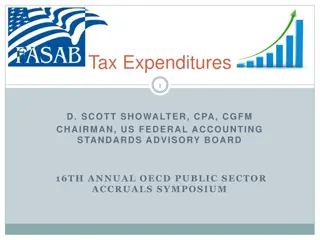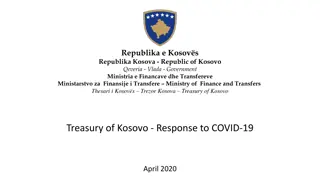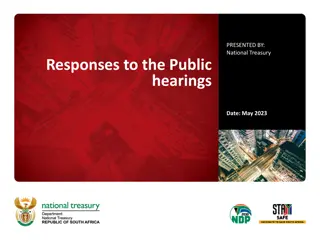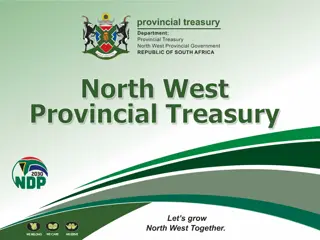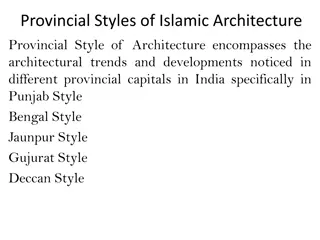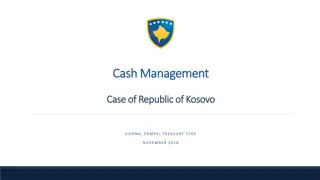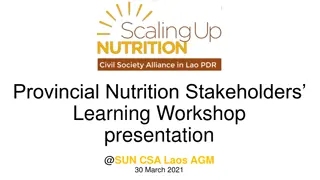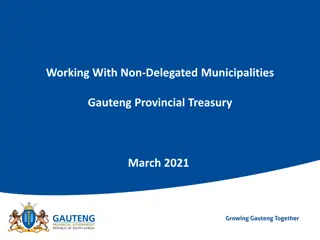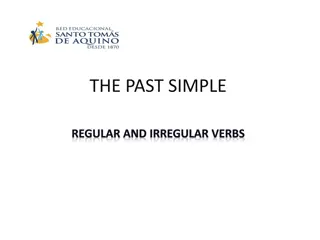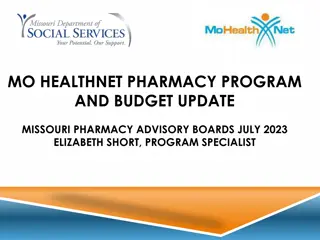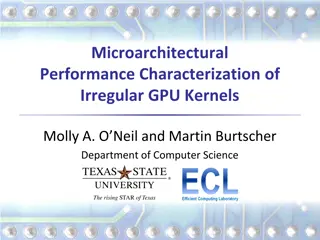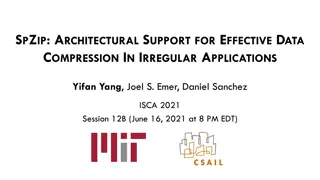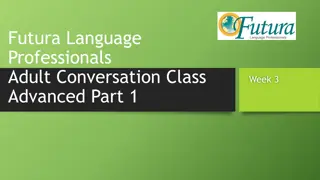Provincial Treasury Process for Dealing with Irregular Expenditures
The Provincial Treasury outlines the process for handling irregular expenditures, including the definition of irregular expenditure, regulations introduced, legal opinions, and duties of Accounting Officers (AOs) and Authorized Officials (AAs) to prevent and address irregularities. Various steps and processes are detailed, such as assessment tests, investigations, recovery of losses, disciplinary actions, and control environment improvements.
Download Presentation

Please find below an Image/Link to download the presentation.
The content on the website is provided AS IS for your information and personal use only. It may not be sold, licensed, or shared on other websites without obtaining consent from the author. Download presentation by click this link. If you encounter any issues during the download, it is possible that the publisher has removed the file from their server.
E N D
Presentation Transcript
Provincial Treasury PROCESS ON HOW PT DEALS WITH IRREGULAR EXPENDITURES; INCLUDING THE CONDONATION PROCESS AND REQUIREMENTS 05 April 2023
Definition of Irregular Expenditure Irregular expenditure is defined as expenditure, other than unauthorised expenditure, that is incurred in contravention of or that is not in accordance with a requirement of any applicable legislation, including: (a) The PFMA*, (b) The State Tender Board Act, 1968 (act no. 86 of 1968) or any regulations in terms of that act (c) Any provincial legislation providing for procurement in that provincial government
Regulations of Irregular Expenditure (IE) introduced by NT NTI2 of 2019 and IE Framework issued on 16 May 2019 to further regulate IE for institutions that are subject to the PFMA Legal opinion on the Legislative mandate of the MEC: Finance to condone IE, 02 July 2019 PT processes ToR for Condonation Working Committee Transversal SOP Process Map Disclosure note Condonation request register PT workshop held with departments on IE Framework, 13 August 2019 Revised Legal opinion on Mandate of MEC to condone IE, 23 December 2019 NTI 4 of 2022/23 and PFMA Compliance & Reporting Framework issued on 23 December 2022 to further regulate IE Delegation of Authority, 04 August 2020 PT Circular 27 of 2020 issued to AO s/ AA s, 13 August 2020
Duties and responsibility of AOs and AAs Section 38 and 51 of the PFMA defines the general responsibilities of an AO and AA includes the requirement to take effective and appropriate steps to prevent IE. If the AO and AA s is made aware of alleged IE, NTI2 of 2019 and IE Framework prescribe that the AO/AA do the following: Perform an assessment/determination test to determine the facts and collect information on what caused the transgression, who is responsible, and whether a financial loss was (or will be) suffered; If fraud, corruption or other criminal conduct is suspected, institute a formal investigation by referring the matter to the Provincial Forensic Services; If fraud, corruption or other criminal conduct is confirmed, take further action (e.g., report the matter to SAPS); Recover any financial losses from an external party or responsible official/s, where applicable; Take disciplinary steps against the responsible official/s (which can include a financial misconduct investigation); Address the control environment in order to prevent reoccurrence.
Processes implemented in WCG to deal with IE Departments and public entities conduct pre-checking of orders to proactively detect and prevent IE in process, where practical; All departments conduct post audit testing on payment batches to detect IE in process and to address governance requirements in line with the IE Framework; Transversal SOP on IE issued by PT to assist and guide departments and public entities in managing IE; The Directorate: PG Supply Chain Management within PT introduced the SCM policy commentary process and associated engagements/communications whereby departments and public entities can proactively prevent IE.; Directorate: PG Accounting and Compliance within PT assist departments and public entities with the assessment of IE and provide guidance and advice on the interpretation of legislation; From time to time, the Directorate: PG Accounting and Compliance rolled-out training initiatives to departments and public entities on the assessment and determination of IE; The Provincial Internal Control Forum was also reintroduced to create a platform where departments can share information and best practices; During 2022, the Provincial Internal Audit unit within the Department of the Premier conducted a transversal audit on the implementation of the IE Framework to assist WCG departments in bringing a systematic, disciplined approach to evaluate and improve the effectiveness of governance, risk management and control processes in the implementation of the IE Framework.
Institutionalisation of Condonation of IE by PT Delegation of Authority DDG: Governance and Asset Management condone IE up to R10 million and PT: Head Official condone IE above R10 million. Treasury Circular 27 of 2020 PT advised AO s/AA s on the interpretation and implementation of the IE Framework and process flow to submit requests for condonation of IE to the PAG s office at PT.helpme@westerncape.gov.za; Requirements by AO/AA when requesting condonation of IE by PT (IE Framework criteria) AO/AA confirms that a determination test was conducted; findings and recommendations of the Unit/Function that conducted the determination test; AO/AA confirms that an investigation was conducted in cases of identified fraudulent, corrupt or other criminal conduct; AO/AA confirms that a criminal charge has been laid in the case of alleged fraudulent, corrupt or other criminal conduct; findings and recommendations of a functionary that conducted the investigation; confirm that losses were not incurred and that value for money was achieved;
Institutionalisation of Condonation of IE by PT Treasury Circular 27 of 2020 (cont.) confirm disciplinary action was taken against the responsible employee(s); and confirm remedial actions taken or being taken by the AO/AA to prevent the recurrence of IE in similar circumstances. Terms of Reference of Condonation Working Committee (CWC) PT established a CWC to assist the PT: Head Official in discharging his responsibility i.t.o NTI2 of 2019; Purpose of the CWC is to consider all requests from AO s/AA s and provide clarity and guidance to the delegated PT officials, entrusted with the responsibility to condone/ not condone IE requests as well as to provide reasons and recommendations to AO/AA, when IE is not condoned; The CWC is chaired by the Provincial Accountant General (PAG) and its members consist of 5 SMS from across the PT functional areas; The PG Accounting & Compliance unit within the PAG s office is responsible for the secretariat function. Review of request to condone IE PT: PG Accounting & Compliance unit (secretariat) update its online condonation register, upon receipt of requests from AO s/AA s.
Process implemented to manage condonation of IE Review of request to condone IE (cont.) Preliminary compliance checks conducted against the NT prescribed criteria, by Unit; Details of compliant requests taken up in a presentation, per IE case, per department/public entity and Secretariat share required supporting documentation of IE cases up for discussion at CWC meetings; Non-compliant requests followed-up to address shortcomings and/or further info from AO s/AA s. Secretariat issues a IC compliance report if necessary to highlighted concerns and recommend corrective actions, when deemed necessary. CWC meetings Meetings held when meetings quorate (50 per cent + 1 member); Members are not allowed to vote on a matter where a conflict of interest is identified; Secretariat tables individual cases, followed by deliberation by members prior to voting which takes place on the individual cases; When CWC members identify shortcomings or require additional info, the secretariat follow-up outstanding info with the department or public entity; CWC also invite AO s,AA s or CFOs to attend CWC meetings to provide clarity when required and engage department or public entity based on the information on hand; Meetings are minuted, and decisions to condone/not condone together with reasons for decision taken up in PT response letter for review by PAG (chairperson).
Process implemented to manage condonation of IE Approval of requests to condone IE PT delegated official consider CWC response and recommendation for approval upon request from PAG; Delegated official may request additional information prior to approval of PT response letter. Removal AO s/AA s may remove IE not condoned by PT, if satisfied that the recommendations confirms: the matter is free of fraudulent, corrupt or other criminal conduct; disciplinary action was taken/in the process of being against the responsible employee(s); the department did not suffer any losses; the non-compliance that led to the IE has been addressed to ensure that such expenditure does not recur under similar circumstances. New NT requirements introduced to manage IE PFMA Compliance and Reporting Framework is effective, 3 January 2023; AO s and AA s assigned the power to condone IE, when IE results from an employee exercising a power or performed a duty that falls outside their delegation of authority.
Summary of cases received for condonation Status Number of cases Total applications received for condonation 881 Total applications assessed by the CWC 876 Applications Condoned 531 Applications previously condoned by National Treasury 15 Applications not condoned 128 Applications received - condonation pending 5 Applications for condonation referred back 202 Applications not condoned: IE related to administrative errors and transactions incorrectly classified as irregular expenditure by Department Applications referred back: Department to provide more information regarding the disciplinary action and remedial steps to prevent re-occurrence of IE The oldest case dates back to 2013/14 to date 2022/23, 9 years. The assessments were done since 2020/21, 2021/22 and 2022/23 - 3 financial year cycles.
Way Forward A workshop was held on 3 March 2023, to consult departments IC unit on the new requirements introduced by NT; A PT/NT information session took place on 16 March 2023, where PT communicated the WCG s concerns i.t.o the new requirements, specifically i.r.o.: Lack of guidance/clarity to distinguish when the AO/AA is the relevant authority to condone IE versus PT; The completeness risks identified i.t.o disclosure of IE in the AFS and annual report. PT is in the process of documenting the WCG s concerns i.r.o the new NT requirements and the commentary will be submitted to the National Accountant General for consideration. A Treasury Circular will be issued to AO s and AA s with the interpretation and implementation of the new NT requirements, by 31 March 2023. An updated Transversal SOP on IE will also be issued to departments and public entities to assist with the same. The Directorate: PG Accounting and Compliance will introduce quarterly compliance testing to review IE condoned by AO s and AA s. PT partnered with the National School of Government(NSG) to update the NSG s IE training material and roll-out of the training to all WCG departments and public entities during the 2023/24 financial year.
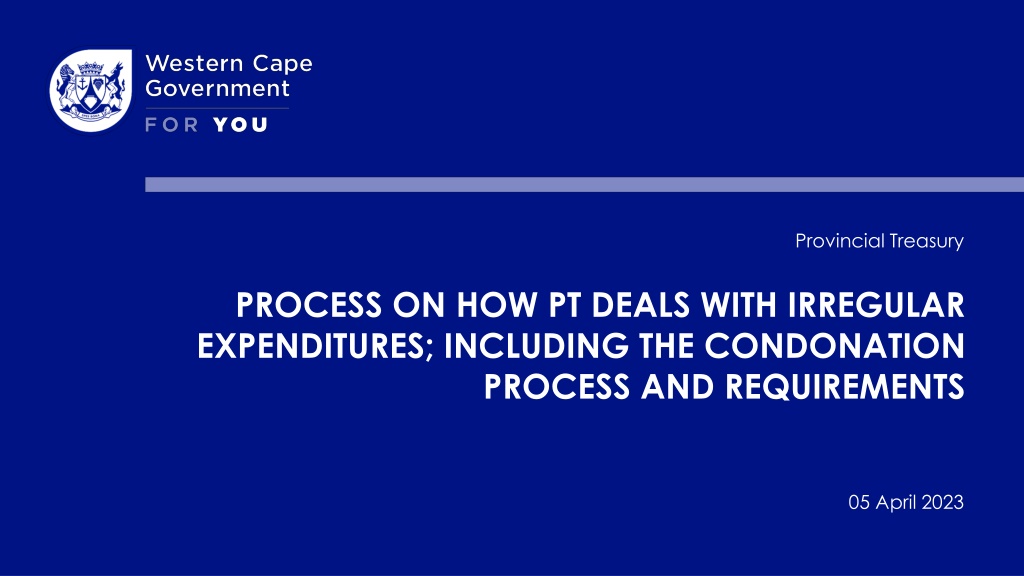
 undefined
undefined





